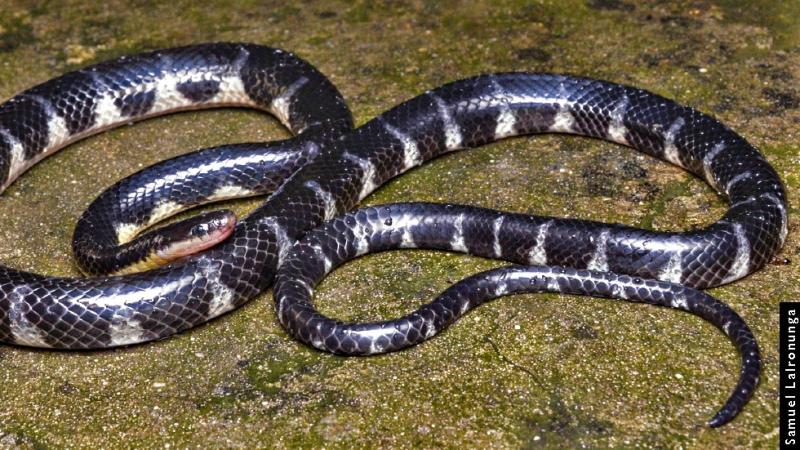
‘Ruahlawmrul’—as the locals call it—is a rain-loving snake currently known only from Aizawl, the capital of Mizoram. In English, it is known as the Mizo rain snake for its love for rain. This black and white zigzag-patterned snake is often seen during the monsoons, near streams close to human settlements, but it has remained undocumented by science until now. A recent study has named it Smithophis atemporalis, marking the discovery of not only a new species but also a new genus, from northeast India.
The study, published in the journal Zootaxa, describes S. atemporalis as a non-venomous snake that is about 2.5 feet long, lays eggs, and feeds on earthworms, juvenile skinks and frogs eggs. A distinguishing feature of this snake is the lack of temporal scales—large scales found on the sides of a snake’s head—which is extremely rare in snakes of this family (Colubridae). Hence, it has been named Smithophis atemporalis. The snout of this snake is truncated and slowly tapers to a smooth curve at the mouth. It is bicoloured with a darker black-grey above and whitish below. The sides of the snake’s body, where the black bands meet the white, trace a zigzag pattern along the length of the snake. Its scales are smooth and glossy.
S. atemporalis has been spotted in and around the Mizoram University campus and some nearby localities. But other than this, not much is known about its distribution, this is because in the past S. atemporalis has been confused with the Bicoloured forest snake.
The newly described snake belongs to the family Colubridae—the largest family of snakes with more than 1,700 species. The family name comes from the Latin word for snake—coluber. S. atemporalis falls under Natricinae, a subfamily of colubrid snakes that are found in or near water, and have rotund bodies and heads that are broader than their bodies.
The discovery is the result of toil by researchers at two Bengaluru-based institutes, National Centre for Biological Sciences (NCBS) and Indian Institute of Science (IISc), along with their collaborators at the Natural History Museum (NHM), London, Wildlife Institute of India (WII), Dehradun, Mizoram University, and Pachhunga University College, Aizawl and Ashok Captain an eminent snake taxonomist from Pune. They were led by Dr. Varad Giri, a researcher at NCBS. He has described several new species of caecilians, geckos and snakes. The study was partially funded by the Scientific and Engineering Research Board (DST-SERB).
The new genus, Smithophis, is named after Malcom A. Smith, a British herpetologist renowned for his contributions to herpetology in India. Smith published three books on the taxonomy of reptiles from the Indian subcontinent between 1931 and 1943. The series, ‘Fauna of British India’ is still a primary resource for anyone that wishes to study Indian reptiles.
Smithophis was initially considered to be a part of the genus Rhabdops that was represented by only two species of snakes separated by a considerable geographical distance. The Olive forest snake (Rhabdops olivaceous) from the Western Ghats and the Bicoloured forest snake (Rhabdops bicolor) from northeast India. DNA analysis and morphological studies by the researchers of the current study established that these two species were not closely related and that the population from northeast India has a lineage that is entirely different from those found in the Western Ghats. Besides, what was once considered to be a single species from the northeast has turned out to be two distinct species, named under the genus Smithophis.
The month of May has borne witness to three new species of snakes from India, with the discoveries of a vine snake (Ahaetulla laudankia) from Odisha, the Arunachal Pitviper (Trimeresurus arunachalensis) from Arunachal Pradesh and now the Mizo rain snake (Smithophis atemporalis) from Mizoram. This unprecedented shower of new species highlights the importance of documenting the herpetofauna of northeast India to raise awareness about the biodiversity that inhabits these delicate and unexplored ecosystems.
This article has been run past the researchers, whose work is covered, to ensure accuracy.





